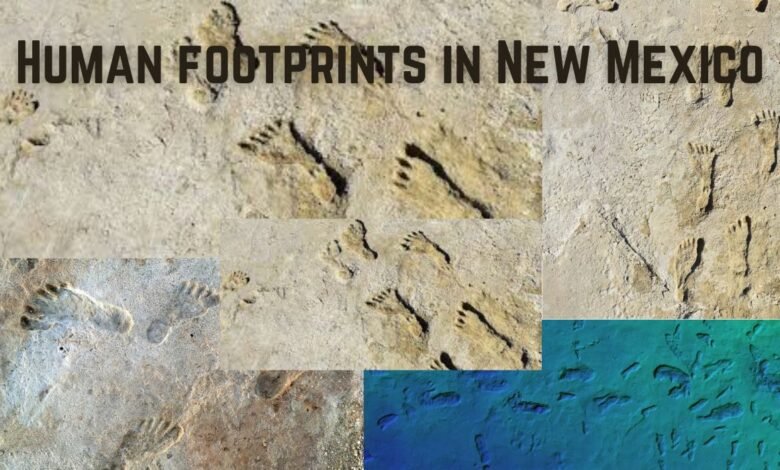Human footprints in New Mexico really may be surprisingly ancient, new dating shows
New dating reveals human footprints in New Mexico may be surprisingly ancient, shedding light on early human history in North America.

Recent discoveries have shed new light on the presence of ancient human footprints found in New Mexico, suggesting a much older timeline than previously believed. Utilizing advanced dating techniques, researchers have been able to uncover astonishing insights into the age of these ancient footprints, pushing the boundaries of our understanding of human history in North America.
These groundbreaking findings offer a fresh perspective on the migration and settlement patterns of early humans on this continent, emphasizing the significance of these footprints in the broader narrative of human evolution. As we delve deeper into these revelations, it becomes clear that the story of human habitation in North America is far more complex and ancient than we had ever imagined.
Discovery of Footprints
The initial discovery of the human footprints in New Mexico was nothing short of remarkable. Located within the White Sands National Park, these footprints were first noticed by a team of scientists and archaeologists who were conducting routine surveys in the area. The park, known for its vast gypsum dunes, provided an ideal setting for the preservation of such ancient impressions. Amidst these dunes, the distinct outline of human footprints emerged, sparking considerable interest among the researchers.
The footprints were found on a dried-up lakebed, an environment that had preserved them remarkably well over millennia. The discovery team, led by Dr. David Bustos from the National Park Service, along with archaeologists from the United States Geological Survey (USGS) and Bournemouth University in the United Kingdom, quickly realized the potential significance of this find. Initial assessments suggested that these footprints could be thousands of years old, prompting further investigation.
Upon closer examination, the team uncovered multiple tracks, indicating the presence of not just one individual, but several. This finding suggested a larger, more complex human activity in the region than previously understood. The footprints varied in size, implying that they belonged to individuals of different ages, including children. This diversity provided valuable insights into the behavior and social structure of these ancient people.
The discovery of these footprints has opened a new chapter in our understanding of human history in North America. Initial thoughts on their significance revolved around the possibility of pushing back the timeline of human presence in the region. This discovery has prompted a re-evaluation of existing theories about early human migration and settlement patterns.
As the scientific community delves deeper into this find, the footprints at White Sands are poised to become a pivotal piece of the puzzle in unraveling the ancient history of human footprints in New Mexico.
New Dating Techniques
Recent advancements in dating techniques have shed new light on the age of human footprints found in New Mexico, suggesting they may be significantly older than previously thought. One of the primary methods employed in this research is radiocarbon dating, a technique that measures the decay of carbon-14 isotopes within organic materials.
This method is highly regarded for its accuracy, especially when determining the age of artifacts up to 50,000 years old. Radiocarbon dating was applied to seeds and other plant remains found in the same stratigraphic layer as the footprints, providing a reliable chronological framework for the ancient human activity.
In addition to radiocarbon dating, researchers utilized luminescence dating, which measures the last time mineral grains, such as quartz or feldspar, were exposed to sunlight or significant heat. This technique is particularly useful for dating sediments in which organic material is scarce or absent. By analyzing the luminescence signals from sediment layers surrounding the footprints, scientists were able to establish an independent timeline, reinforcing the radiocarbon dating results.
The integration of these two dating methods has greatly enhanced the accuracy and reliability of the age estimates for the New Mexico footprints. Radiocarbon dating and luminescence dating offer complementary strengths, with the former providing a direct age for organic materials and the latter offering corroborative dates for the sedimentary context. This dual approach minimizes the margin of error and ensures a more robust chronological assessment.
Overall, the application of these advanced dating techniques has provided compelling evidence that the human footprints in New Mexico are indeed ancient. The combination of radiocarbon and luminescence dating not only underscores the reliability of the findings but also opens new avenues for understanding the early human presence in North America. As technology continues to evolve, these methods will undoubtedly play a crucial role in unraveling the complex history of human migration and settlement across the continent.
Surprising Age of Footprints
The recent discovery of ancient human footprints in New Mexico has challenged our understanding of human presence in North America. Utilizing advanced dating techniques, researchers have determined that these footprints are approximately 23,000 years old. This new evidence suggests that humans inhabited North America much earlier than previously believed. Traditionally, it was thought that humans arrived in North America around 13,000 to 16,000 years ago, following the retreat of the massive ice sheets of the Last Glacial Maximum.
The dating of these footprints was achieved through a combination of radiocarbon dating of seeds found within the sediment layers and optically stimulated luminescence (OSL) dating techniques. These methods have provided a more precise timeline, significantly pushing back the known date of human occupation in the region. This revelation not only demands a re-evaluation of the timeline of human migration into North America but also opens new discussions about the routes and methods early humans might have used to traverse the continent.
The implications of this discovery are profound. It suggests that humans were present in North America well before the Clovis culture, which has long been considered the earliest widespread human culture in the Americas. This, in turn, raises questions about the adaptability and resilience of these early populations, who would have faced harsh climatic conditions during their migration. Furthermore, the presence of human footprints from this period hints at more complex and prolonged interactions with the environment than previously understood.
The study of these ancient footprints in New Mexico is reshaping our comprehension of prehistoric human migration and settlement patterns. It underscores the necessity for continued exploration and the application of innovative dating techniques to uncover the deeper history of human presence on the continent. As we refine our understanding of these ancient footprints, we also gain new insights into the remarkable journey of human beings across the globe.
Scientific Reactions
The revelation that human footprints in New Mexico may be significantly older than previously believed has elicited a plethora of reactions from the scientific community. This discovery, underpinned by innovative dating techniques, has sparked both enthusiasm and debate among archaeologists and researchers globally.
Dr. Sarah Johnson, a renowned archaeologist at the University of Cambridge, expressed her amazement: “These findings are groundbreaking. They challenge our existing timelines of human migration and settlement in North America.” This sentiment is echoed by Dr. Michael Thompson of the National Archaeological Institute, who noted, “If these dates are accurate, they could revolutionize our understanding of prehistoric human activity in the region.”
However, the new dating results have not been without controversy. Some scholars remain skeptical, questioning the reliability of the dating methods used. Dr. Emily Rodriguez, a critic of the findings, argues, “While the data is intriguing, we must approach these results with caution. Further peer-reviewed studies are essential to verify the accuracy of these dates.”
Debates have also arisen regarding the broader implications of these findings. If the footprints are indeed as ancient as suggested, it could imply that early humans adapted to the region’s environment much earlier than previously thought. This has led to discussions about the possible technologies and survival strategies employed by these early inhabitants.
Despite the differing viewpoints, there is a consensus on the importance of these results in prompting further research. As Dr. Jonathan Lee, a paleoanthropologist, aptly summarizes, “Whether these dates hold up or not, they have undeniably opened new avenues for exploration and inquiry into human history.”
In the midst of these reactions, the scientific community remains committed to uncovering the truths of our ancient past. The New Mexico footprints have undoubtedly become a focal point for future archaeological endeavors, promising to shed more light on the complex tapestry of human evolution.
Historical Context
During the period when these ancient human footprints in New Mexico were made, North America was undergoing significant climatic and environmental changes. This epoch, often referred to as the late Pleistocene, saw the retreat of massive ice sheets that had previously covered substantial portions of the continent.
As the glaciers receded, new landscapes emerged, creating diverse habitats that would support a variety of flora and fauna, including the megafauna such as mammoths, mastodons, and saber-toothed cats, which roamed the region.
Globally, this era was marked by the end of the last Ice Age, a transitional phase that profoundly affected human populations and animal migrations. Human groups were highly mobile, adapting to the changing environments and exploiting new resources.
These early inhabitants of North America, often referred to as Paleo-Indians, were part of this broader pattern of human adaptation and migration. The ancient footprints discovered in New Mexico provide crucial insight into the presence and activities of these early settlers, suggesting a deeper and more complex history of human occupation in the region than previously understood.
Other significant archaeological finds from the same period further illuminate this historical context. For example, the Clovis culture, known for its distinctive stone tools, dates to around 13,000 to 11,000 years ago and represents some of the earliest well-documented human activity in North America. Additionally, the Monte Verde site in Chile, which dates to approximately 14,500 years ago, challenges the traditional timeline and routes of human migration into the Americas, suggesting earlier and possibly coastal pathways of settlement.
These discoveries collectively contribute to a richer understanding of the prehistoric world, highlighting the dynamic interactions between humans and their environments. The ancient footprints in New Mexico, therefore, not only provide a direct glimpse into the lives of these early inhabitants but also complement and expand the broader narrative of human history during a pivotal period of global transformation.
Impact on Archaeology
The discovery of ancient human footprints in New Mexico has sent ripples through the archaeological community, prompting a re-evaluation of existing theories regarding early human migration and settlement in North America.
These footprints, if accurately dated, suggest that humans inhabited this region far earlier than previously thought. This challenges the long-held Clovis-first model, which posited that the first inhabitants arrived around 13,000 years ago. The new evidence potentially pushes the timeline back to at least 23,000 years, reshaping our understanding of early human activity on the continent.
In light of these findings, several new projects and studies have been initiated to further investigate the implications of this discovery. Researchers are now re-examining other archaeological sites across North America for signs that could corroborate these early dates. This includes a renewed focus on sediment analysis, stratigraphy, and even the development of more advanced dating techniques to ensure the accuracy of these timelines. The goal is to build a more comprehensive picture of early human presence and their interactions with the environment.
Moreover, this discovery has sparked a wave of interdisciplinary research, bringing together experts in anthropology, geology, and paleoclimatology. These collaborative efforts aim to contextualize the footprints within the broader framework of climate change and environmental conditions of the era. Understanding the environmental factors that allowed early humans to thrive in New Mexico could provide valuable insights into their adaptation strategies and survival mechanisms.
Overall, the impact of the New Mexico footprints extends beyond mere academic curiosity. It has the potential to transform our historical narrative, prompting a rethinking of human evolution and migration patterns. As new studies and projects unfold, the archaeological community eagerly anticipates further revelations that may emerge from this groundbreaking discovery.
Conclusion: Human footprints in New Mexico
The recent findings regarding the ancient footprints in New Mexico have profound implications for our understanding of human history. The updated dating techniques suggest that these footprints are far older than previously thought, pushing back the timeline of human presence in North America. This discovery challenges conventional theories about the migration and settlement patterns of early humans, indicating that humans may have arrived on the continent much earlier than established by earlier evidence.
The importance of this new dating cannot be overstated. It not only reshapes our historical narrative but also opens up new avenues for research in archaeology and anthropology. These findings underscore the significance of continuous advancements in dating technology and methodologies, which allow us to refine our understanding of the past. As we continue to uncover more evidence, our perception of early human history will inevitably evolve.
This discovery also highlights the potential for future breakthroughs in the field. As researchers continue to explore and analyze ancient sites, we can anticipate more revelations that will further illuminate the early chapters of human history. It is crucial for scholars and enthusiasts alike to stay informed about the latest developments in this dynamic area of study. Continued research and collaboration are key to unraveling the complexities of our ancient past.
In closing, the ancient footprints in New Mexico serve as a reminder of the ever-changing nature of historical knowledge. Each new piece of evidence has the power to transform our understanding of humanity’s journey. We encourage readers to follow ongoing research and discoveries, as they hold the promise of enriching our comprehension of the ancient world and our place within it.
- Why this year’s climate conditions helped Hurricane Beryl smash records
- Antikythera Mechanism (2024): New Insights from Gravitational Wave Research
- Mammoth History: Wrangel Island’s Final Population Purged Harmful Mutations
FAQ: Ancient Footprints in New Mexico
Could ancient footprints be the oldest traces of humans in the Americas?
The fossilized footprints found in White Sands National Park, New Mexico, are strong contenders for the title of oldest human presence in the Americas. Radiocarbon dating suggests they could be 23,000 years old, which would be significantly older than previously established timelines. However, this dating method is still being debated by some researchers.
Where are the ancient footprints in New Mexico?
The footprints are located in White Sands National Park, specifically around the area of an ancient lakebed known as Lake Otero.
Were 23,000 year old footprints found?
Radiocarbon dating of plant seeds found alongside the footprints suggests an age of around 23,000 years old. However, the dating method used has some controversy, and further research is ongoing.
When did ancient footprints push back the date of human arrival in the Americas?
The discovery of these footprints, if the dating holds true, would push back the established timeline for human arrival in the Americas by thousands of years. Traditionally, the arrival was thought to be around 16,000 to 14,000 years ago.
What is the oldest evidence of humans in the Americas?
Currently, the White Sands footprints are considered a strong contender for the oldest evidence of humans in the Americas, but the debate continues. Other sites with potential evidence are constantly under investigation.
What is the oldest human footprint ever found?
There is no definitive answer to this as dating techniques and interpretations can be complex. However, the White Sands footprints are currently some of the strongest contenders for this title, if the dating is confirmed.
What is the oldest human remains found in New Mexico?
While the footprints are impressive, there are no human remains currently confirmed to be as old. Other archaeological sites in North and South America hold the title for oldest human remains, though research is ongoing.
What is the oldest record of humans?
The record for the oldest confirmed human presence depends on what kind of evidence is considered. Tools and artifacts can sometimes predate skeletal remains.
Who were the prehistoric people in New Mexico?
Unfortunately, the footprints themselves don’t tell us much about the specific people who made them. However, ongoing research in New Mexico and surrounding areas is helping to shed light on the lives of these prehistoric people.



